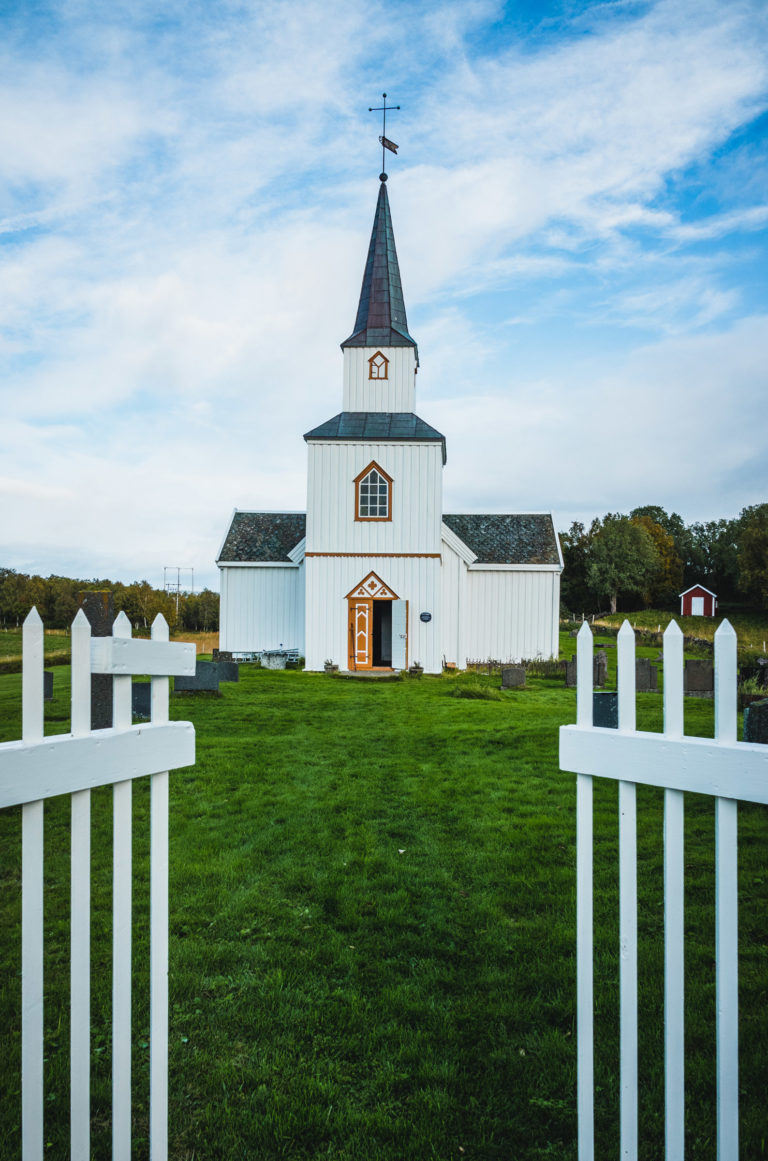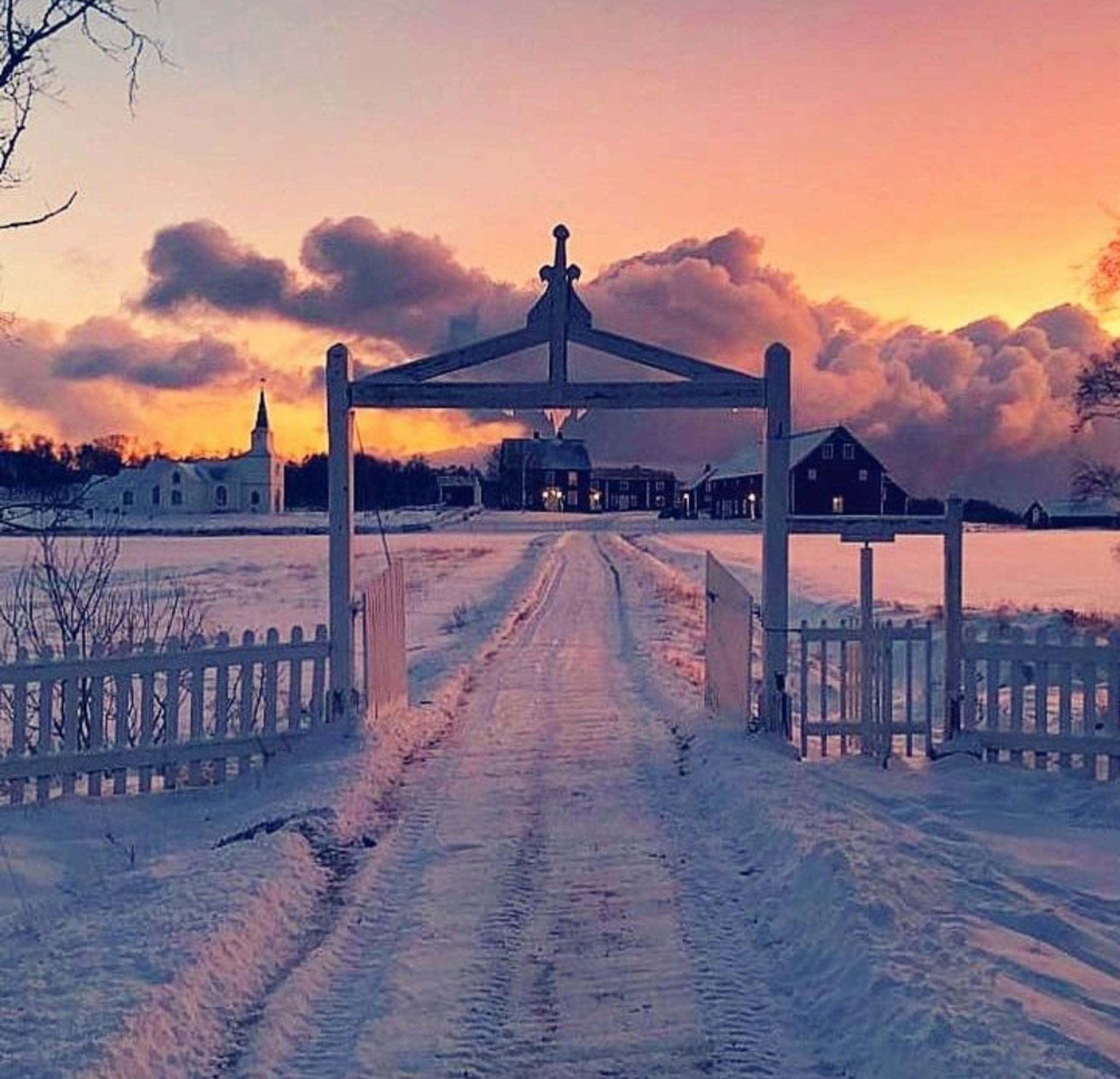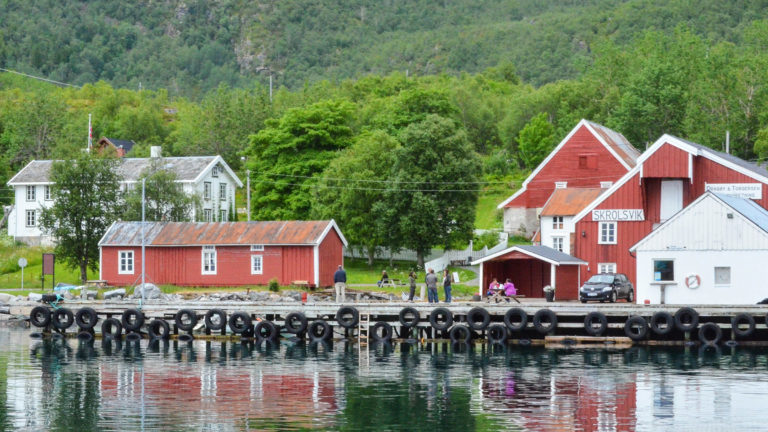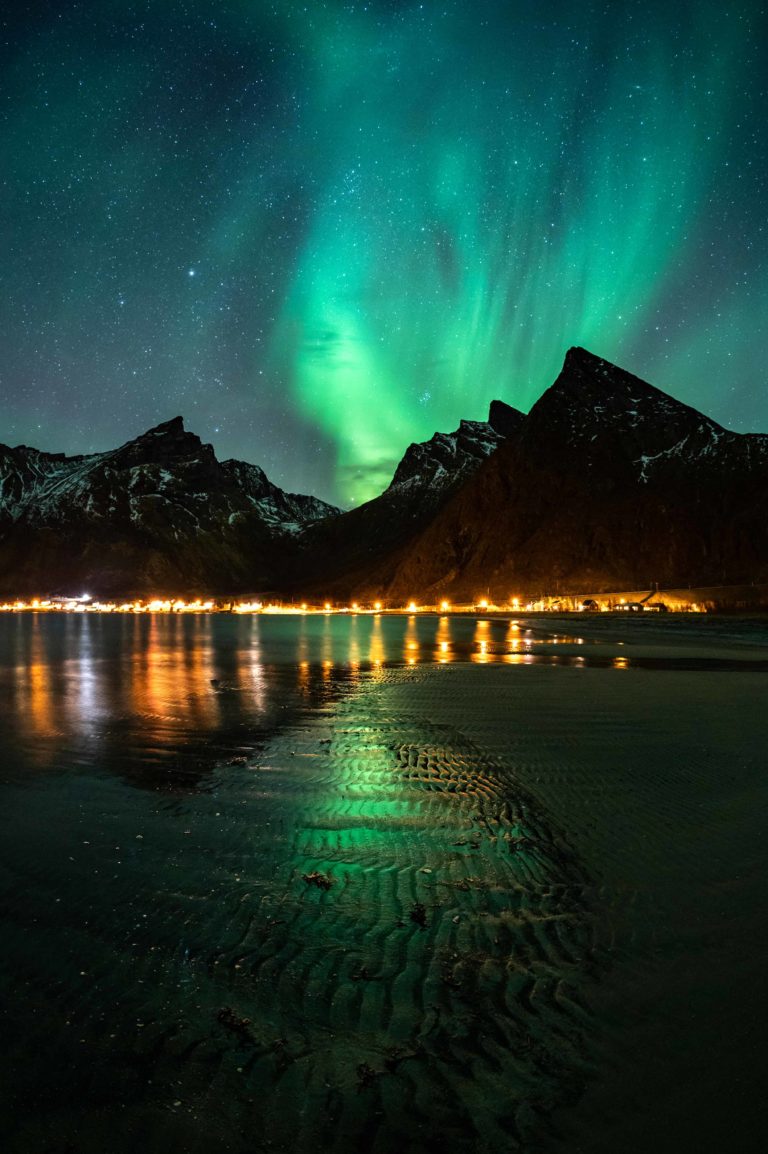Wenche took me in her motorboat from a wooden, weather-beaten pier onto the bay of Tranøybotn in lovely early summer weather. The shallow water was transparent blue, or brilliantly green as we glided over passages of sandy seabed. There were lots of islets around, some mere rocks, others with big trees on. “I’ll make a detour, so that you can see it from the sea” she smiled. As the boat glided gently on the calm waters, the dense forest on land opened to a white wooden church and some rather big buildings in earthy red with a hint of rust. All was surrounded by green fields, and it wouldn’t have looked much different 250 years ago. Wenche steered her little boat to a little dock on Tranøya Island, and we could begin our exploration.
The grand view awaits around the bend
We walked up the Sjyveien – the road to the sea – from the picturesque red boat houses near the dock through the lush forest. As the road curved, the chat quieted down. In front of us, we saw a wooden gateway, and behind it the whole complex. The white church and the magnificent red buildings were meant to impress from this angle.
The church of Tranøya is modest and intimate
The church was first stop. Wenche turned the big key, and opened the door for me. The small narthex is dominated by the epitaph of Jens Christensen and Karen Andersdatter. The minister, his wife, Karen’s first, deceased husband and all their children, alive and dead, looked down on us. We progressed into the church itself through a squeeky door. The ceiling is low, the pews narrow and hard and a gallery swings around the western half of the church. The building dates from 1773, and is thus the oldest church in central Troms.
The church interior is more atmospheric than grandiose
The altarpiece is rather strange. Positioned above the altar in the chancel, its upper part has been cut off above the crucifixion of Christ. The upper most section, the ascension, is placed above the chancel arch. This happened in 1871, when panelling was installed beneath the chancel ceiling, making it lower. The style of the chancel and the pulpit is 17th c. baroque, and is characterised by naivety and and a rather amateurish finish. Three chandeliers adorn the nave, all given by parishioners around the time the church was built.
Rickety ladders lead to secrets
A visit in the church of Tranøy is always with a local guide. I was shown up to the gallery, filled with narrow, hard pews. From here, one sees the interior from a different angle. One can wander around the organ. Wenche showed me the rickety ladder to a tower room, filled with old objects stored away. From here, there was an even more peculiar view of the interior. A walk around the cemetery finished the visit, with old graves and metal crosses.
The old vicarage is beautifully preserved
An impressive building is the old vicarage. It dates from around 1750 and is long and narrow. This is typical for 18th century stately buildings in the north. We wandered around the old rooms, where old glass windows afforded views out into the other buildings, the fields and the church. There is little furniture left in the house, as vicars would typically bring their furniture with them, and take it along as they left. The walls are unrestored and the floors upstairs flex and squeek under the weight of a man. Here there are small exhibits about history themes from the area. This includes the history of the crofters, people who rented their land from landowners.
The new vicarage hides the mod-cons
In 1856, a new vicarage was built. It is today the guesthouse on the island. Again, the furniture followed the vicar, so there isn’t so much left. Instead, the restauration has kept the old elements, and the new furnishing is discreetly modern. Here one can stay comfortably for a couple of nights. Walk around the island to Viking graves, have Wenche show you the old vicarage and the church and eat good food. And bring a good book. All kinds of activities can be made on request, but calm is what you come to the island for.
Tranøya is a small island in a quiet bay
Not much more than a kilometre across and a square kilometre and a half in size, the island of Tranøya is a flat, lush and green island with tall trees and green fields. For millennia, the island was under water, but rose up from the Tranøybotn bay some 3000 years ago. For at least 2000 years, people have been farming these fields, and burial mounds are found in the forested areas dating from the first centuries AD to the introduction of Christianity in the 11th C. The biggest is some 11 metres across. A trained eye can also spot remnants of boat houses from as far back as the pre-Viking iron age.
The present church is the third
We must imagine the farm at Tranøya Island as a seat of a local headman back in the Viking age. It probably had close relations to the northernmost chieftains in Norway’s Viking age, residing on the island of Bjarkøy. In the 11th c, Christianity was introduced. We cannot be sure when the first church was built on Tranøya Island, but it might have happened in the mid-13th c. There is information on the church itself, but a statue of Saint Sunniva from around 1490 once adorned this church. Today, she can be admired in the University Museum of Tromsø. At some point, the medieval church was replaced by a new church. This church was reported around 1750 to be in a bad state, leading to the construction of the new church in 1773. In 1775, it was consecrated.
Illustrious vicars lived on the island
The old churches only had a chaplain under the more prominent parish of Ibestad. The chaplain also administered schools for the Sami people in the fjords on the mainland. It was of course important to educate the Sami in the Lutheran faith. In 1759, the church got its own vicar, living permanently on the island. The first was the headstrong Elling Rosted, who worked hard to improve schools for his parishioners, causing conflict with the big taxpayers. The young Trondheimer Nils Norman, vicar from 1803, was equally dedicated to enlightening the parishioners. He created the first library in Northern Norway, the Tranøe Almuebogsamling, – Tranøy Library for Commoners. This is also a theme at the exhibits in the old vicarage.
Was there a love triangle on Tranøya around 1800?
The vicar Tobias Brodkorb Bernhoft arrived in Tranøy in 1797 with some baggage. With him was the renowned Anna Catharina Juel from Copenhagen. She had run Madam Juels Coffee House there, a favourite watering hole for the Norwegian theology students at Copenhagen’s university. Norway, being in union with Danmark at the time, had no university yet. Here, the Norwegian Society, a Norwegian student fraternity, met. The poetry of some of the merry students is still part of Norway’s school curriculum. When she was 56, she met the young student Bernhoft, and they developed a warm friendship. We don’t know how warm. In 1792, she followed him to Northern Norway, first to Måsøy near the North Cape, and then in 1797 to Tranøy.
What happened to Anna Catharina?
In 1800, when Anna Catharina was 70 and Tobias 36, he married the 28-year-old vicar’s daughter Anna Elisabeth. For two years, there were two women in the vicarage. Tobias Brodkorb Bernhoft died in 1802, and his wife moved back to her family with one child and pregnant with a second. Anna Catharina Juel, lacking a safety net, was welcomed to the neighbouring vicarage of Lenvik, but then we lose track of her for some time. In 1808 she was inscribed in the poorhouse in Trondheim, and in 1809 she died. The most prominent socialite in Copenhagen ended up in a nameless grave in Trondheim. We can never know the nature of the relationship between Tobias and Anna Catharina, but we know they were a fascination in their time.
Tranøya went from central to remote
Another illustrious vicar was Jørgen Christian Holmboe, who served as Tranøy’s vicar for 35 years from 1872. He was even more interested in developing the farm than preaching the gospel. Notably he welcomed English bird hunters to the island, and the place could be quite lively with international visitors. However, in the 20th c, roads were built around the fjord, and it felt less natural to sail to church. In 1960, a new vicar moved to a new vicarage at Stonglandseidet, and in the autumn of 1965, the livestock was driven across to Senja Island at low tide, and the island abandoned. In 1976, new tenants came. Today, the island is run like as a small boutique resort and can be visited by appointment.
Practical information
Tranøya is an island just off the south coast of Senja. The town of Finnsnes is about 1 hour’s drive north east, and the city of Harstad is found across the fjord in the south.
There is no public transportation. Visits to Tranøya are organised by appointment with Senja Moments Tranøya.
Tranøya has comfortable accommodation with all mod cons.
Visit Senja has updated information about attractions, accommodation, dining and travelling on their website. For a more meandering approach, you can read our Senja articles.
You take the catamaran from Tromsø to Finnsnes, a good hour’s sailing. From Finnsnes, you take the bus to Tranøybotn for another hour. From there, Senja Moments Tranøya will organise transport to the island if contacted ahead.




































